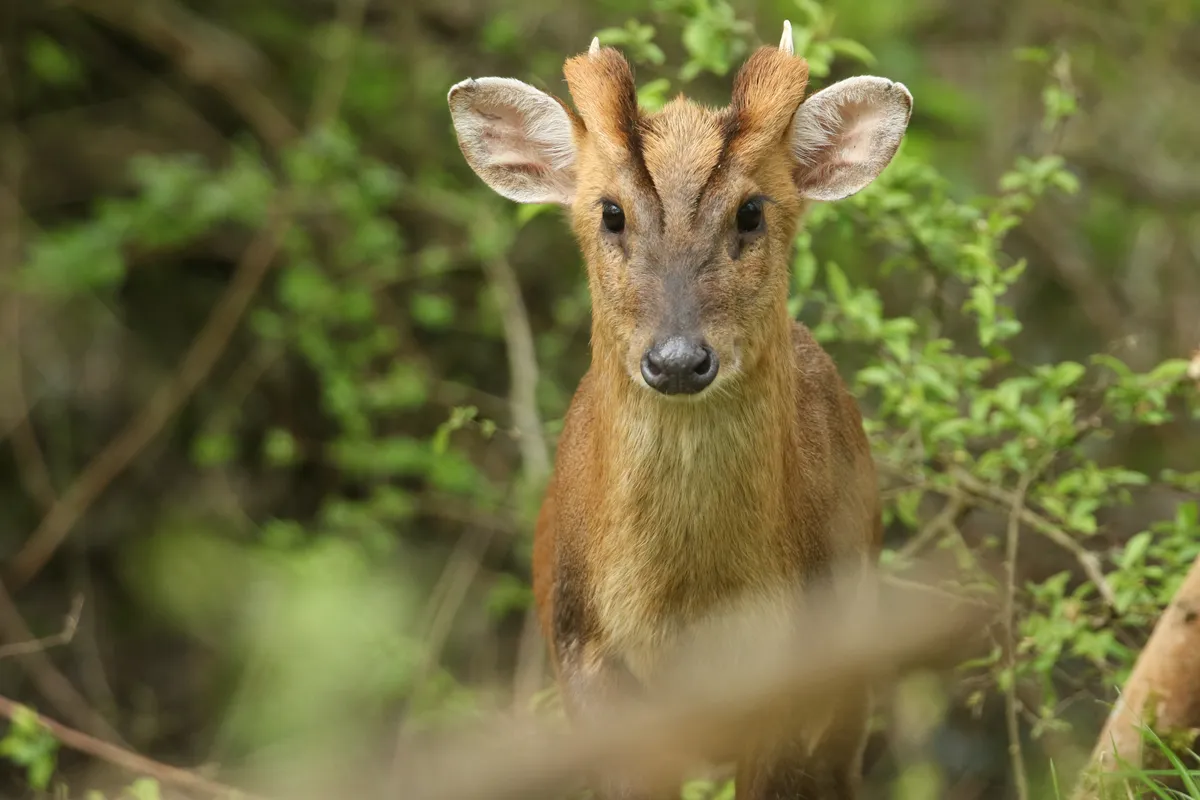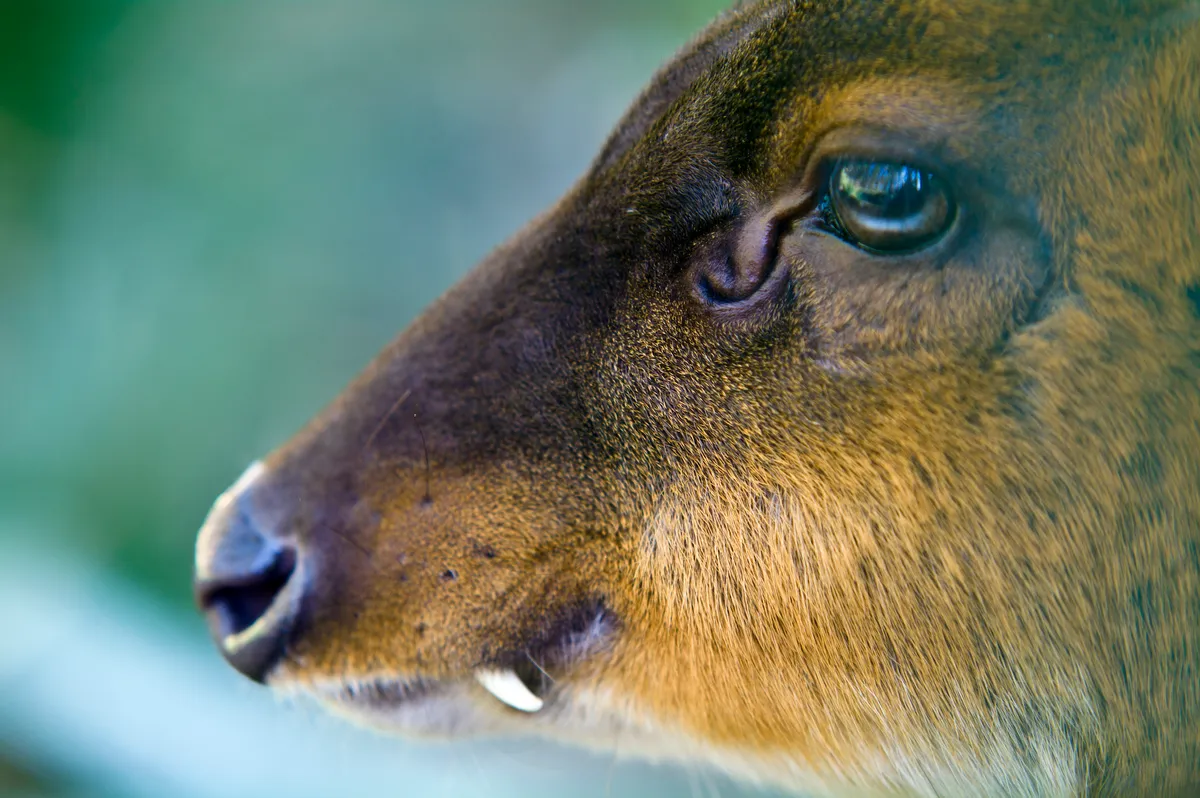Although common in the British countryside, a recently viral video has shed new light on the seemingly bizarre adaptations of the muntjac deer. Many animals have the ability to inflate, but this is typically more widely seen in birds, fish, and amphibians than it is in mammals.
Along with a handful of mammals like some primates, elephant seals, and walruses, the muntjac deer is blessed with the cool ability of being able to inflate parts of its body. And the secret to its delightfully flappy face? It’s all down to their incredible scent glands.
What is a muntjac deer?
Muntjac deer are small, stocky mammals about the size of a small to medium dog. Reaching a shoulder height of around 45-52cm, they’re the smallest species of deer in Britain and have tiny hooves to match, just 2cm wide by 3-4cm long. They’re built for agility and speed, while their large, expressive eyes hint at a mischievous nature.
Their copper-brown coat turns a dull grey colour in the winter, camouflaging them with the dappled colours of the forest floor.

Muntjacs are an adaptive species and with no specific breeding season, can produce year-round offspring.
Globally, there are at least seven species of muntjac, but it’s the Reeves’ muntjac (muntiacus reevesi) that has thrived and established a new home for itself in the UK.
What’s with the nose?
There’s one standout reason why muntjacs have captured people’s attention and become a viral sensation: the inflating glands on their face.
Growing and swelling like balloons filling with air, these peculiar features are actually scent glands. And there are two sets on the muntjac’s face: the preorbital scent glands, which are just in front of the eyes, and the frontal glands on the forehead. When relaxed, they look nothing more than small bumps on the deer’s face, but to other muntjacs, they are a crucial tool for communication and bonding.
As the scent glands expand, they secrete a personalised concoction of chemical compounds that convey information about a deer's sex, age, and reproductive status, as well as their overall health, well-being, and social hierarchy. Rubbing their face against a tree (or other objects), this scent acts like a calling card; a message to other creatures in the forest that the muntjac deer is present.
This behaviour is particularly important when males want to defend their territory and establish dominance over other deer in order to attract a mate (although this can occur in both sexes).
Muntjac, like other species of deer, have other not-so-obvious scent glands, including the tarsal and metatarsal glands on their feet, and the interdigital glands between the split hooves of the front and back feet. To further add to this individual scent concoction, the deer will pee on their tarsal glands and rub them together, a behaviour known as ‘rub-urination’.
Are muntjac deer native to the UK?
Despite now being found across England and Wales, muntjac actually originate from the forests of southeast Asia, including parts of India, China, Taiwan, and Indonesia. They were brought over to the UK and were obtained by the Zoological Society of London as early as 1838, before being introduced at Woburn Park, later in the 19th Century.
Sometime in the early 20th Century, however, they either escaped from their confines at Woburn or were deliberately released, into the surrounding countryside. Over the following years, muntjacs spread to other parts of the UK, becoming a common sight in many rural and suburban areas.
Of the six species of deer now found across Britain (red deer, roe deer, European fallow deer, sika deer, water deer and muntjac deer), only the red deer and roe deer are indigenous.
What do muntjac deer eat?
Foodies at heart, part of the reason for muntjacs' success in the UK is their appetite for a wide range of culinary delights. Their discerning palates lead them on a daily adventure as they explore the forest floor, and their diverse diet includes fruits, nuts, seeds, and fungi.
They're also particularly fond of the tender shoots and leaves of young trees, which can somewhat hinder forest management programmes. Muntjac deer are also known to enjoy a good crunch, and can often be found chomping on crunchy bits of woody vegetation.
Despite their enthusiasm for vegetarian cuisine, muntjac deer are not above adding a little protein to their diet. They have been known to occasionally snack on insects, snails, and other small invertebrates, which they catch with lightning-fast reflexes. The muntjac deer's eclectic diet reflects their adventurous and curious nature, as they explore the rich tapestry of flavours and textures that the forest has to offer.
Can muntjac deer swim?
On land, deer are built for speed. They can jump, too, and have been seen jumping over a 1.2m-high fence. Although muntjacs aren’t known for their swimming prowess, they can swim, and may do so to cross rivers, or escape predators.
Why do muntjac deer have fangs?
Muntjac have long canine teeth protruding from their top jaw, which are sometimes referred to as ‘fangs’ or ‘tusks’. These teeth are present in both males and females, and are typically longer and more prominent in males, particularly during the breeding season.
These teeth are not traditionally used for hunting, instead, they’re primarily used for display and territorial scuffles with other muntjacs. So, while they do have somewhat vampire-like teeth, they’re not actually used for drinking blood or any other vampiric activity, despite the media hype. And they’re not typically used to cause serious harm to other animals or humans.

What do muntjac deer sound like? Do they really bark?
Muntjac have a variety of vocalisations, ranging from soft grunting noises to something resembling a human scream. They’re also known as the ‘barking deer’ thanks to their loud, resonant (and repeating) bark, which sounds a bit like a loud cough.
This type of bark is unique to muntjacs, and they can be very vocal given their petite size. It’s often used as a territorial call, and males will also bark to attract a female, or to ward off predators. If you live near muntjacs, be warned – this barking can go on for many hours…
Are muntjac deer endangered?
Here in the UK, muntjac were classified as an invasive, non-native species in 2019. As cute as they are, this means it’s actually illegal to release them into the wild, import them, breed them in captivity or sell them.
However, they are protected in the UK under the Deer Act 1991 and are not considered endangered. In fact, populations have been steadily increasing thanks to their adaptability and ability to thrive in a variety of habitats.
Read more:
